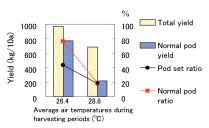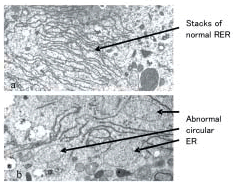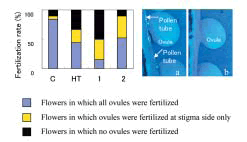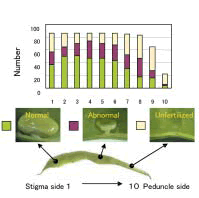Occurrence of abnormal pods and abscission of flowers at high temperatures in snap bean
Description
[Objectives]
As the result of high temperature stress, which causes damage to plants during the reproductive growth stage, production of temperate vegetables in tropical and subtropical areas has become unstable. However, research has thus far not completely discerned how reproductive organs are damaged under conditions of high temperature stress.
[Results]
Under high temperature stress, the yield reduction in snap bean (Phaseolus vulgaris) was closely related to the abscission of flowers and occurrence of abnormal pods (Fig. 1). To understand how this occurs, researchers investigated how the organs that maintain pollen viability, which is critical to fertilization, might be impaired by heat. It was discovered that high atmospheric temperatures alter the structure of the endoplasmic reticulum in the tapetum and disenable the tapetum to supply nutrients to microspores in the anther (Fig. 2). The tapetum degenerates earlier than usual, resulting in high pollen sterility, and anther indehiscence occurs when pollen stainability falls below 20 percent.
Pollen tubes were stained with aniline blue to make the ovule more observable under optimum conditions, although heat treatment still limits visibility. Researchers were still able to determine that heat stress at the flowering stage blocked pollen tube elongation in the style, particularly high temperatures exactly occurring one day before flowering (Fig. 3). Both normal pollen development in the anther and normal pollen tube elongation in the style are necessary for successful fertilization under high temperature conditions.
Abnormal pods occurred along with failure of fertilization because the pollen tubes did not reach the ovules on the peduncle side under high temperatures. Even when fertilization occurred successfully, abnormal pods appeared with poor ovule development (Fig. 4).
These effects also occurred in the field when air temperatures exceeded 28°C. Pollen fertility, pollen tube elongation, and ovule development after fertilization are important factors allowing the production of normal pods in snap bean.
Figure, table
-
Fig. 1. Relationship between average air temperatures, yield and pod set ratio (cv. ‘Kentucky wonder’). -
Fig. 2. Endoplasmic reticulum (ER) in tapetum at the uninucleate pollen stage.
a, normal conditions (24°C);
b, high temperature conditions (29°C). -
Fig. 3. Left, Changes in ovule fertilization rate after heat treatment; right, fertilized ovules (a) and non-fertilized ovules (b). C, Control (27/23°C); HT, Heat treatment day (29 ~ 34 °C, 18h); 1, 1 day after HT (27/23°C); 2, 2 days after HT (27/23°C). -
Fig. 4. Growth of ovules at different positions in abnormal pods.
- Affiliation
-
Japan International Research Center for Agricultural Sciences Okinawa Subtropical Station
- Classification
-
Technical A
- Term of research
-
FY2002 (FY2001-2005)
- Responsible researcher
-
SUZUKI Katsumi ( Okinawa Subtropical Station )
SHONO Mariko ( Okinawa Subtropical Station )
EGAWA Yoshinobu ( Okinawa Subtropical Station )
- ほか
- Publication, etc.
-
Suzuki, K., Takeda, H., Tsukaguchi, T. and Egawa, Y. (2001): Ultrastructural study on degeneration of tapetum in anther of snap bean (Phaseolus vulgaris L.) under heat stress. Sexual Plant Reproduction, 13, 293-299.
Suzuki, K., Tsukaguchi, T., Takeda, H. and Egawa, Y. (2001): Decrease of pollen stainability of green bean at high temperatures and relationship to heat tolerance. Journal of the American Society for Horticultural Science, 126 (5), 571-574.
- Japanese PDF
-
2002_23_A3_ja.pdf807.4 KB
- English PDF
-
2002_23_A4_en.pdf74.36 KB




